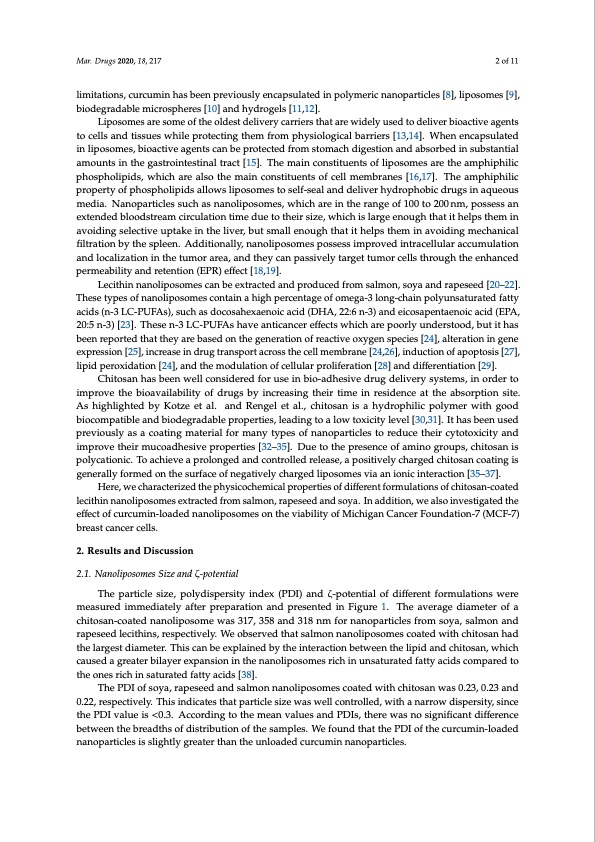
PDF Publication Title:
Text from PDF Page: 002
Mar. Drugs 2020, 18, 217 2 of 11 limitations, curcumin has been previously encapsulated in polymeric nanoparticles [8], liposomes [9], biodegradable microspheres [10] and hydrogels [11,12]. Liposomes are some of the oldest delivery carriers that are widely used to deliver bioactive agents to cells and tissues while protecting them from physiological barriers [13,14]. When encapsulated in liposomes, bioactive agents can be protected from stomach digestion and absorbed in substantial amounts in the gastrointestinal tract [15]. The main constituents of liposomes are the amphiphilic phospholipids, which are also the main constituents of cell membranes [16,17]. The amphiphilic property of phospholipids allows liposomes to self-seal and deliver hydrophobic drugs in aqueous media. Nanoparticles such as nanoliposomes, which are in the range of 100 to 200 nm, possess an extended bloodstream circulation time due to their size, which is large enough that it helps them in avoiding selective uptake in the liver, but small enough that it helps them in avoiding mechanical filtration by the spleen. Additionally, nanoliposomes possess improved intracellular accumulation and localization in the tumor area, and they can passively target tumor cells through the enhanced permeability and retention (EPR) effect [18,19]. Lecithin nanoliposomes can be extracted and produced from salmon, soya and rapeseed [20–22]. These types of nanoliposomes contain a high percentage of omega-3 long-chain polyunsaturated fatty acids (n-3 LC-PUFAs), such as docosahexaenoic acid (DHA, 22:6 n-3) and eicosapentaenoic acid (EPA, 20:5 n-3) [23]. These n-3 LC-PUFAs have anticancer effects which are poorly understood, but it has been reported that they are based on the generation of reactive oxygen species [24], alteration in gene expression [25], increase in drug transport across the cell membrane [24,26], induction of apoptosis [27], lipid peroxidation [24], and the modulation of cellular proliferation [28] and differentiation [29]. Chitosan has been well considered for use in bio-adhesive drug delivery systems, in order to improve the bioavailability of drugs by increasing their time in residence at the absorption site. As highlighted by Kotze et al. and Rengel et al., chitosan is a hydrophilic polymer with good biocompatible and biodegradable properties, leading to a low toxicity level [30,31]. It has been used previously as a coating material for many types of nanoparticles to reduce their cytotoxicity and improve their mucoadhesive properties [32–35]. Due to the presence of amino groups, chitosan is polycationic. To achieve a prolonged and controlled release, a positively charged chitosan coating is generally formed on the surface of negatively charged liposomes via an ionic interaction [35–37]. Here, we characterized the physicochemical properties of different formulations of chitosan-coated lecithin nanoliposomes extracted from salmon, rapeseed and soya. In addition, we also investigated the effect of curcumin-loaded nanoliposomes on the viability of Michigan Cancer Foundation-7 (MCF-7) breast cancer cells. 2. Results and Discussion 2.1. Nanoliposomes Size and ζ-potential The particle size, polydispersity index (PDI) and ζ-potential of different formulations were measured immediately after preparation and presented in Figure 1. The average diameter of a chitosan-coated nanoliposome was 317, 358 and 318 nm for nanoparticles from soya, salmon and rapeseed lecithins, respectively. We observed that salmon nanoliposomes coated with chitosan had the largest diameter. This can be explained by the interaction between the lipid and chitosan, which caused a greater bilayer expansion in the nanoliposomes rich in unsaturated fatty acids compared to the ones rich in saturated fatty acids [38]. The PDI of soya, rapeseed and salmon nanoliposomes coated with chitosan was 0.23, 0.23 and 0.22, respectively. This indicates that particle size was well controlled, with a narrow dispersity, since the PDI value is <0.3. According to the mean values and PDIs, there was no significant difference between the breadths of distribution of the samples. We found that the PDI of the curcumin-loaded nanoparticles is slightly greater than the unloaded curcumin nanoparticles.PDF Image | Growth-Inhibitory Effect of Chitosan-Coated Liposomes Encapsulating Curcumin

PDF Search Title:
Growth-Inhibitory Effect of Chitosan-Coated Liposomes Encapsulating CurcuminOriginal File Name Searched:
836c1ae26776a79725d4c4adee6113bbdd36.pdfDIY PDF Search: Google It | Yahoo | Bing
CO2 Organic Rankine Cycle Experimenter Platform The supercritical CO2 phase change system is both a heat pump and organic rankine cycle which can be used for those purposes and as a supercritical extractor for advanced subcritical and supercritical extraction technology. Uses include producing nanoparticles, precious metal CO2 extraction, lithium battery recycling, and other applications... More Info
Heat Pumps CO2 ORC Heat Pump System Platform More Info
| CONTACT TEL: 608-238-6001 Email: greg@infinityturbine.com | RSS | AMP |